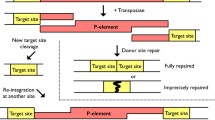Summary
The morphology and genetical characteristics of a new dominant homoeotic mutation, called Distal into proximal (Dipr), are described. Dipr causes two main abnormalities, both of which are specific to distal regions of the adult appendages (i.e. the wing, haltere, legs, antenna, and proboscis); first that distal parts are reduced in size and second that the patterns found distally resemble those normally localised in more proximal parts. The mutation maps to the right arm of chromosome 3 and is associated with an inversion with breakpoints in 84D and 84F. Analysis of revertants of Dipr show that the right breakpoint of In(3R)Dipr is the one responsible for the mutant phenotype. Complementation analyses of Dipr revertants and dosage studies of Dipr with different doses of Dipr + indicate that the mutant is a hypermorph affecting the normal expression of a gene localised in 84F. The developmental significance of the mutation is discussed.
Similar content being viewed by others
References
Bryant PJ (1978) Pattern formation in imaginal discs. In: Ashburner M and Wright TRF (eds) The genetics and biology of Drosophila, vol 2c. Academic Press, London, pp 230–335
Denell RE (1973) Homoeosis in Drosophila. I. Complementation studies with revertants of Nasobemia. Genetics 75:279–297
Duncan IW, Kaufman TC (1975) Cytogenetic analysis of chromosome 3 in Drosophila melanogaster. Mapping of the proximal portion of the right arm. Genetics 80:733–752
Garcia-Bellido A (1975) Genetic control of wing disc development in Drosophila. In: Cell patterning 29. Ciba Foundation Symposium. Elsevier, Amsterdam, pp 161–182
Garcia-Bellido A (1977) Homoeotic and atavic mutations in insects. Am Zool 17:613–629
Garcia-Bellido A, Ripoll P, Morata G (1973) Developmental compartmentalisation of the wing dise of Drosophila. Nature New Biol 245:251–253
Garcia-Bellido A, Ripoll P, Morata G (1976) Developmental segregation in the dorsal mesothoracic disc of Drosophila. Dev Biol 48:132–149
Garcia-Bellido A, Santamaria P (1972) Developmental analysis of the wing disc in the mutant engrailed of Drosophila melanogaster. Genetics 72:87–104
Kaufman TC, Lewis RA, Wakimoto BT (1980) Cytogenetic analysis of chromosome 3 in Drosophila melanogaster. The homoeotic gene complex in polytene chromosome interval 84A-B. Genetics 94:115–133
Kemphues KJ, Raff EC, Raff RA, Kaufman TC (1980) Mutation in a testis specific beta-tubulin in Drosophila. Analysis of its effects on meiosis and map location of the gene. Cell 21:445–451
Kornberg T (1981) Engrailed: A gene controlling compartment and segment formation in Drosophila. Proc Natl Acad Sci USA 78:1095–1099
Lawrence PA, Morata G (1976) Compartments of the wing of Drosophila: a study of the engrailed gene. Dev Biol 50:321–337
Lefevre G (1976) A photographic representation and interpretation of the polytene chromosomes of Drosophila melanogaster salivary glands. In: Ashburner M and Novitski E (eds) The genetics and biology of Drosophila. Academic Press, London, pp 32–64
Lewis EB (1978) A gene complex controlling segmentation in Drosophila. Nature 276:565–570
Lifschytz E, Green MM (1979) Genetic identification of dominant overproducing mutations. The Beadex gene. Mol Gen Genet 171:153–159
Lindsley DL, Grell EH (1968) Genetic variations of Drosophila melanogaster. Carnegie Inst Wash Publ No 627
Lindsley DL, Sandler L, Baker BS, Carpenter ATC, Denell RE, Hall JC, Jacobs PA, Miklos GLG, Davis BK, Gethman RC, Hardy RW, Hessler A, Miller SA, Nozawa H, Parry PM, Gould-Somero M (1972) Segmental aneuploidy and the genetic gross structure of the Drosophila genome. Genetics 71:157–184
Loosli R (1959) Vergleich von Entwicklungspotenzen in normalen, transplantierten und mutierten Halteren-Imaginalscheiben von Drosophila melanogaster. Dev Biol 1:25–64
Martin P, Martin A, Shearn A (1977) Studies of 1(3)c43 hsl a polyphasic, temperature sensitive mutant of Drosophila melanogaster with a variety of imaginal disc defects. Dev Biol 55:213–232
Morata G, Lawrence PA (1977) Homoeotic genes, compartments and cell determination in Drosophila. Nature 265:211–216
Morata G, Kerridge S (1981) Sequential functions of the bithorax complex of Drosophila. Nature 290:778–781
Muller HJ (1932) Further studies on the nature and causes of gene mutations. Proc Sixth Intern Congr Genetics 1:231–255
Nüsslein-Volhard C, Wieschaus E (1980) Mutations affecting segment number and polarity in Drosophila. Nature 287:795–801
Ouweneel WJ (1976) Developmental genetics of homoeosis. Adv. Genet 18:179–248
Ouweneel WJ, Van der Meer JM (1973) Differentiation capacities of the dorsal metathoracic (haltere) disc of Drosophila melanogaster: I. Normal organ map. Wilhelm Roux's Arch Entwicklungsmech Org 172:149–161
Postlethwait JH (1978) Development of cuticular patterns in the legs of a cell lethal mutant of Drosophila melanogaster. Wilhelm Roux's Arch Entwicklungsmech Org 185:37–57
Shearn A, HErpsberger G, Herpsberger E (1978) Geentic analysis of two allelic, temperature sensitive mutations of Drosophila melanogaster, both of which are zygotic and maternal effect lethals. Genetics 89:341–353
Simpson P, Schneiderman HA (1975) Isolation of temperature sensitive mutations blocking clone development in Drosophila melanogaster, and the effects of a temperature sensitive cell lethal mutation on pattern formation in imaginal discs. Wilhelm Roux's Arch Entwicklungsmech Org 178:247–275
Struhl G (1981) A homoeotic mutation transforming leg to antenna in Drosophila. Nature 292:635–638
Tobler H (1966) Zellspezifische Determination und Beziehung zwischen Proliferation und Transdetermination in Bein- und Flügelprimordien von Drosophila melanogaster. J Embryol Exp Morphol 16:609–633
Wakimoto BT, Kaufman TC (1981) Analysis of larval segmentation in lethal genotypes associated with the Antennapedia gene complex (ANT-C) in Drosophila melanogaster. Dev Biol 81:51–64
Author information
Authors and Affiliations
Additional information
Communicated by K. Illmensee
Rights and permissions
About this article
Cite this article
Kerridge, S. Distal into proximal (Dipr): A homoeotic mutation of Drosophila melanogaster . Mol Gen Genet 184, 519–525 (1981). https://doi.org/10.1007/BF00352532
Received:
Issue Date:
DOI: https://doi.org/10.1007/BF00352532




